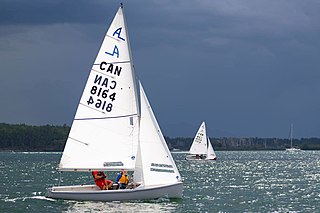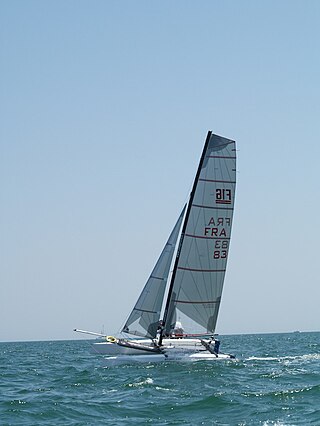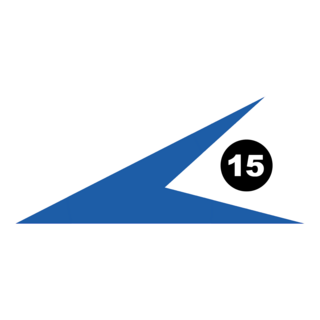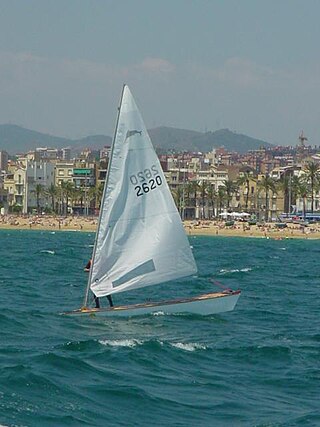
A catamaran is a watercraft with two parallel hulls of equal size. The distance between a catamaran's hulls imparts resistance to rolling and overturning. Catamarans typically have less hull volume, smaller displacement, and shallower draft (draught) than monohulls of comparable length. The two hulls combined also often have a smaller hydrodynamic resistance than comparable monohulls, requiring less propulsive power from either sails or motors. The catamaran's wider stance on the water can reduce both heeling and wave-induced motion, as compared with a monohull, and can give reduced wakes.

The Tornado is a double handed multihull class recognised as an International Class by the International Sailing Federation. It was used for the Catamaran discipline at the Olympic Games from 1976 to 2008.

The Albacore is a 4.57 m (15 ft) two-person planing dinghy with fractional sloop rig, for competitive racing and lake and near-inshore day sailing. Hulls are made of either wood or fiberglass. The basic shape was developed in 1954 from an Uffa Fox design, the Swordfish. Recent boats retain the same classic dimensions, and use modern materials and modern control systems.

The Optimist is a small, single-handed sailing dinghy intended for use by young people up to the age of 15.

The ISAF International Class Hobie 16 (H16) is a popular catamaran manufactured by the Hobie Cat Company for racing and day sailing. The craft was the driving force behind the popularization of beachcats and was recently inducted into the Sailing Hall of Fame.

Hobie Cat is a company that manufactures watercraft and other products as the Hobie Cat Company. "Hobie Cat" can also refer to specific products of the company, notably its sailing catamarans. Its fiberglass catamaran models range in nominal length between 14 feet (4.3 m) and 18 feet (5.5 m). Rotomolded catamaran models range in length between 12 feet (3.7 m) and 17 feet (5.2 m). Other sailing vessels in the Hobie Cat lineup include, monocats, dinghies, and trimarans, ranging in length between 9 feet (2.7 m) and 20 feet (6.1 m). Its largest product was the Hobie 33, 33 feet (10 m) in length. The company's non-sailing product line includes surfboards, kayaks, stand-up paddle boards, pedalboards, eyeware, and e-bikes. It was founded in 1961 by Hobart (Hobie) Alter, who originally manufactured surfboards.

The A-Class Catamaran, often abbreviated to A-Cat, is a development class sailing catamaran for singlehanded racing.

The Formula 16 (F16) sport catamaran is an ISAF recognised 5 m long beach catamaran with an asymmetric spinnaker setup.
A mast-aft rig is a sailboat sail-plan that uses a single mast set in the aft half of the hull. The mast supports fore-sails that may consist of a single jib, multiple staysails, or a crab claw sail. The mainsail is either small or completely absent. Mast-aft rigs are uncommon, but are found on a few custom, and production sailboats.

A sailing hydrofoil, hydrofoil sailboat, or hydrosail is a sailboat with wing-like foils mounted under the hull. As the craft increases its speed the hydrofoils lift the hull up and out of the water, greatly reducing wetted area, resulting in decreased drag and increased speed. A sailing hydrofoil can achieve speeds exceeding double and in some cases triple the wind speed.

The Dart 15 is a one-design 15-foot-long (4.6 m) glassfibre sailing catamaran, principally sailed in the UK. It is designed to be sailed by one or two people and has a furling jib and trapeze. It can be raced with or without the jib and trapeze, and there are national championships held in both categories. Between 2005 and 2022 the class was known as the Sprint 15.
The 2000(formerly the Laser 2000) is a performance sailing dinghy designed by Phil Morrison and currently sold by RS Sailing. It combines a traditional GRP hull and foam sandwich deck moulding with a modern asymmetric rig including a furling jib, reefing mainsail and single line gennaker hoist system.
The Hurricane 5.9 is a one design racing catamaran. It was designed by Reg White in Brightlingsea in the 1980s in response to a Tornado catamaran owner's request that White Formula design a cat with equal or superior performance to the Tornado of roughly the same boat length and sail area that did not need to be dismantled for trailing, this was to be the Hurricane 5.9.
The Dart 18 is a one-design 18-foot (5.5 m) long glassfibre sailing catamaran. It is designed to be sailed by two people and can achieve speeds of up to 20 knots. This is reflected in its Portsmouth Yardstick of 805 and D-PN of 76.3

The Topcat is a one-design sailing catamaran boat class which is divided into several boat sizes.
The Splash Dinghy is 3.5 m in length and all boats are identical, thus, as is typical in One-Design classes, the sailor's ability rather than equipment is emphasised fleet racing. The boats employ an un-stayed mono rig with a sail area of 6.3 m2, which makes the class easy to handle by sailors ranging from 45 to 80 kg. This, combined with the low hull weight of 55 kg, allow the class to serve as a stepping stone between the Optimist Dinghy and boats such as the Laser Radial, suiting sailors in the age range from 13 to 21 years.

Patín a vela, also known as Patín catalán or Catalan catamaran , is a class of boat "one-design" of dinghy sailing with a single crew member. Characterized by being a catamaran with a single sail of type marconi without boom and the peculiarity of not having rudder nor centreboard. The steering of the boat is carried out with the movement and distribution of the weight of the skipper along the length and width of the deck of the ship and with the sheet, which holds the sail. It is specially designed to be used on the beach, this is the reason for not having centreboard or rudder.

The Hobie 17 is an American catamaran that was designed by John Wake as a single-handed racer and first built in 1985.
The Trac 14 is an American catamaran sailing dinghy that was designed by Australians Richard McFarlane and Jay McFarlane as a one-design racer and first built in 1980.
The Prindle 18 is an American catamaran sailing dinghy that was designed by Geoffrey Prindle as a racer and first built in 1977.













